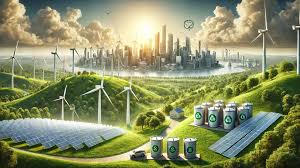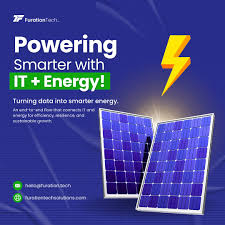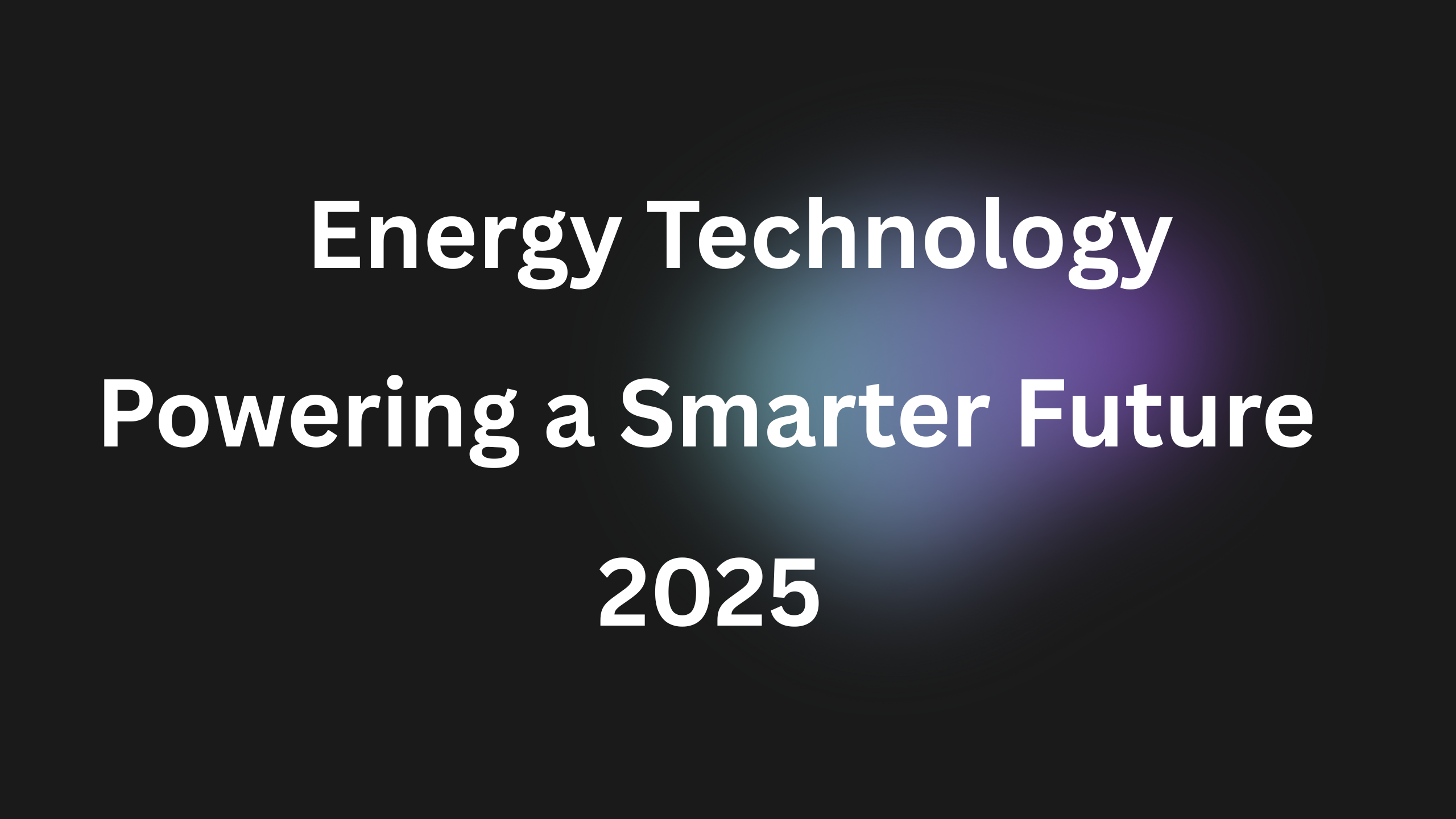Introduction
Consider this: You stagger to the kitchen for coffee at 7 AM as your alarm clock blares like a caffeinated rooster. But wait—your smart fridge, which is powered by a solar panel on your roof that quietly generates clean electricity, has already placed an order for beans after noticing that your supply was low. Does it sound like science fiction?
Did you know that investments in clean energy are expected to overtake those in oil and gas for the first time ever by 2025? Yes, S&P Global predicts that solar photovoltaics alone will account for half of all cleantech spending this year. We’re discussing a radical transition away from fossil fuels and toward renewable energy, where energy technology is about more than just turning switches—it’s about turning the tide on climate catastrophe.
As an expert in digital marketing who has witnessed more “going green” initiatives than a salad bar leprechaun, I can assure you that energy technology is the unsung hero that is making our world more bizarre, exciting, and productive. This post explores the exciting world of energy technology, whether you’re a boomer eyeing that electric lawnmower or a Gen Z dreamer planning your off-grid tiny home. We’ll discuss trends, laugh at the hiccups, and get a sneak peek at the power plays of the future. Hold on tight—both the environment and your energy bill will appreciate it.
What Is Energy Technology?
Have you ever wondered why, on Monday mornings, your phone charges more quickly than your motivation? Thank energy technology, or blame it. Fundamentally, energy technology is the magic that makes it possible to produce, store, transform, and distribute energy in ways that are efficient, safe, and (hopefully) environmentally friendly. Imagine it as the backstage crew for everything from your Netflix marathon to enormous wind farms that spin like ceiling fans that are too energized by caffeine.
Simply put, energy technology connects the dots between the energy that powers your life and the raw resources, such as sunlight or wind. It’s the science of sustainability, not just technology. The worst part is that without it, we would still be sulking in the dark with our laptops while rubbing sticks for fire.
See our beginner’s guide for more in-depth information.
A Quick History Lesson
Yesterday, energy technology did not emerge from a laboratory. No, it began in the eighteenth century with the steam engine, which chugged along like a Victorian grandmother en route to bingo. In the 1950s, nuclear power enters the 20th century, promising atoms for peace (and a few Cold War scares). When the 2000s arrived, renewable energy sources took over; according to the International Energy Agency, the price of solar panels has decreased by 89% since 2010.
In 2025, energy technology has matured, fusing modern intelligence with traditional dependability. From cumbersome coal-fired power plants to modern batteries that might outlast your New Year’s resolutions, it has changed over time. Putting humor aside, if history tells us anything, it’s that energy technology develops most quickly during periods of rising bills—talk about driven innovation!

Top Energy Technology Trends for 2025
Energy technology is expected to stop whispering and start shouting in 2025. The trends are hotter than a server farm in July, with the demand for electricity rising 2.5% yearly worldwide (kudos to data centers and EVs consuming power like children at a candy store). Shall we break them down?
| Trend | Description | Impact in 2025 |
|---|---|---|
| AI Integration | Smart algorithms optimizing grids in real-time | Reduces waste by 15%, per McKinsey |
| Solar Dominance | PV costs hit record lows | 50% of cleantech investments |
| Energy Storage Boom | Batteries scaling up for renewables | Enables 24/7 clean power |
| Green Hydrogen | Electrolysis tech for hard-to-decarb sectors | $100B investment surge |
| Grid Modernization | Digital twins for resilient infrastructure | Handles 20% more demand |
This table? It’s your cheat sheet to why energy technology is the MVP of the decade. Pro tip: If you’re into visuals, explore our infographic on renewable energy trends.
AI-Powered Smart Grids
Imagine this: An artificial intelligence (AI) that is more intelligent than your GPS and less likely to lead you through a cow pasture. AI is transforming smart grids, which are networks that expertly balance supply and demand, much like Red Bull’s jugglers. According to the World Economic Forum, by 2025, AI will be able to predict outages before your lights flicker, reducing downtime by 30%.
Funny enough, these smart grids will soon remind you to close the refrigerator—through an app notification, of course. LSI nod: By reducing waste and increasing energy efficiency, this contributes to sustainable energy.
Renewable Energy Boom
Renewables are the energy technology’s biggest stars, not just a trendy term. According to Bloomberg NEF, solar and wind energy are driving the trend, with 510 GW of installations worldwide in 2024 alone. Policy changes in 2025 give green technology a huge boost; consider tax credits that lower the cost of panels compared to the typical impulsive purchase.
The amusing part: wind turbines? As we worry about the little things, nature’s fans cool the earth. Key LSI: Solar energy and wind turbines are revolutionizing green energy.

How Energy Technology Powers Daily Life
Energy technology isn’t locked in some mad scientist’s lab—it’s in your pocket, your car, and probably flirting with your toaster. From charging your EV overnight to optimizing home energy use via apps, it’s the invisible thread weaving sustainability into chaos.
- Home Hacks: Smart thermostats like Nest learn your habits, saving 10-15% on bills. Energy storage batteries keep the lights on during blackouts—because who needs candlelit dinners every night?
- Transport Triumphs: Electric vehicles (EVs) now boast 300+ mile ranges, powered by lithium-ion wizardry. Bonus: Fewer gas station stops mean more road-trip sing-alongs.
- Work Wins: Data centers? They’re guzzling 2% of global power, but energy technology like liquid cooling slashes that footprint.
These aren’t pie-in-the-sky dreams; they’re here, making life greener (and cheaper). Dive deeper with our post on energy efficiency tips for homeowners.
From Solar Panels to EVs
Previously costly eyesores, solar panels are now stylish rooftop devices that feed energy back into the grid. When you combine them with EVs, you have a combination that is equal parts eco-warrior and money-grubbing. By 2025, your car will be able to power your house thanks to bidirectional charging—what a mobile battery!
Humor twist: EVs will ambush you like that friend who eats your fries because they are so quiet. LSI integration: This combination increases the use of renewable energy.
Challenges in Energy Technology
There is no rose without thorns, is there? The challenges facing energy technology are more formidable than a bad hair day. Rare earth metal supply chain snarls? Verify. Are smart grids at risk from cybersecurity? Verify again. Not to mention the “not in my backyard” crowd who object to wind farms because they obstruct their beloved gnome collection’s view.
Here’s the hopeful chuckle, though: These difficulties are merely new developments in the grand energy technology story. Answers? battery recycling initiatives and threat detection powered by AI. By 2025, changing policies will calm market dynamics, claims RSM US.
Overcoming the Hurdles
Beat the blues with innovation: Modular nuclear reactors promise safe, small-scale power without the meltdown memes. Green hydrogen tackles industrial emissions—think steel mills gone clean. It’s all about collaboration; governments, techies, and you (yes, you) turning “impossible” into “I’m possible.”
Read more: Tech poised to change the world: Top Ten Emerging …
The Future of Energy Technology
Gaze into the crystal ball: By 2030, fusion energy could join the grid, per Los Alamos labs—unlimited power without the waste. Quantum batteries? Super-efficient storage. And don’t sleep on geothermal: Tapping Earth’s heat like an infinite hot tub.
In this energy technology utopia, costs plummet, access skyrockets, and we all high-five over carbon neutrality. Slightly humorous forecast: Robots will install your panels while you nap—efficiency level: expert.
LSI roundup: Smart grids, energy storage, and sustainable energy will dominate. For forward-thinking reads, see our vision for 2030 renewables.
Energy technology’s future isn’t just bright—it’s solar-powered incandescent. Imagine cities lit by fusion, farms irrigated by wind-derived hydrogen. Deloitte predicts a supply-demand crunch in 2025, but breakthroughs like advanced perovskites for solar (efficiency >30%) will bridge it.
Personal story time: I once installed a home battery during a storm—woke up to neighbors begging for juice. That’s the relatable revolution. As investments hit $2 trillion (BloombergNEF), energy technology democratizes power, from rural microgrids to urban skyscrapers.
Hurdle humor: Cybersecurity? It’s like dating in 2025—everyone’s swiping, but hackers are the ghosts. Solutions evolve faster, with blockchain securing transactions.
Daily life expansion: In kitchens, induction stoves (energy tech darlings) cook 90% more efficiently. At work, VR meetings cut travel emissions. For kids: STEM toys teaching circuits via play. All ages? Check—boomers save on AC, zoomers flex on Insta with off-grid vans.
Trends deep-dive: AI not just predicts; it optimizes EV fleets, routing for wind power peaks. Renewables: Floating offshore wind—turbines bobbing like party boats, generating 15 GW by 2025.
Challenges fix: Policy? Inflation Reduction Act extensions fuel growth. Community buy-in? Education campaigns turn skeptics to cheerleaders.
Future fluff: By 2040, ambient energy harvesting from Wi-Fi? Your router powers your watch. Wild? Yes. Inevitable? With energy technology’s pace, bet on it.
Read more: AI in 2025: The “new electricity” could create huge economic …
Summary
What a fast-paced exploration of the fascinating realm of energy technology! 2025 will mark the turning point where green ideals and practical realities collide, from AI-smarts modernizing grids to solar’s meteoric ascent. We’ve marveled at achievements, laughed at hiccups, and charted a course for a sustainable future where energy efficiency is a joy rather than a chore. Adopting energy technology, whether it’s making adjustments to your thermostat or considering an electric vehicle upgrade, will result in lower expenses, cleaner air, and a legacy of “they did it” for the grandchildren. The trends? You can’t miss them. The effect? Revolutionary. It’s your turn now; jump in, come up with something new, and let’s get stronger together.
Are you prepared to take the world by storm? Let’s start a discussion by exchanging your most outrageous energy technology anecdotes or queries below! For more expert advice and green giggles, subscribe. How are you starting down the path to sustainable energy? Now leave a comment!
Read more: What is Medical Technology? Best Guide 2025
Frequently Asked Questions
What is energy technology?
Energy technology encompasses tools and systems for producing, storing, and distributing energy efficiently. It includes renewables like solar power and wind energy, plus innovations in batteries and grids. In essence, it’s the backbone of modern life, turning natural resources into usable power while minimizing environmental harm—think less waste, more watts for your daily grind.
What are the main types of energy technology?
Key types include renewable energy (solar, wind, hydro), fossil fuel tech (though fading), nuclear fission/fusion, and emerging stars like green hydrogen and energy storage solutions. Each plays a role in the mix, with renewables leading 2025’s charge for sustainability and cost savings.
How is energy technology advancing in 2025?
Advancements spotlight AI for smart grids, plummeting solar costs, and scaled-up battery storage. Investments top $1.5 trillion, per experts, enabling 24/7 clean power and EV integration. It’s a boom year, slashing emissions while boosting efficiency—your future self will thank the innovators.
What are the benefits of investing in energy technology?
Benefits? Lower energy bills (up to 20% via efficiency), job creation (millions in cleantech), and planetary perks like reduced CO2. Plus, energy independence and tech perks like smart homes. It’s a win-win: save cash today, secure tomorrow—humorously, it’s cheaper than therapy for climate guilt!
What is the future of energy technology?
The future shines with fusion power by 2030, quantum storage, and universal access via microgrids. Expect hyper-efficient renewables and AI-orchestrated global networks. Challenges like supply chains? They’ll fade as innovation accelerates, painting a carbon-neutral canvas where energy technology fuels equity and adventure for all.

